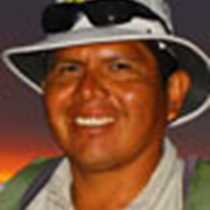At six in the morning, with a very clear sunrise over the low cliff of Darwin’s Bay, National Geographic Endeavour II was anchored in the interior of a flooded caldera, to start our last full day of the expedition in the Galapagos Islands. Without any doubt, we saved the best for the end…
Genovesa was named after Genoa of Italy, the birthplace of Christopher Columbus. This pancake-like island, the summit of a submerged volcano, is located at the northeastern-most point of the Galapagos Islands. It’s a small, very low island about two hundred fifty feet from the highest cliff, but has a huge diversity of flora and fauna because of its unique location. Genovesa is a place where an abundance of bird species are found, including nesting red-footed and Nazca boobies, and various land birds.
As we approached Darwin’s Beach, we were welcomed by a flock of juvenile red-footed boobies doing their flying lessons. Then, along the trail, male Nazca boobies were picking up pebbles and twigs to impress their mates. We saw different life stages of swallow-tailed gulls — the only nocturnal seagulls in the world — including courtship, mating, and even a fluffy chick in the nest. Over half of the red-footed boobies in the Galapagos nest on Genovesa, and we had a chance to not only see the birds in large numbers but to get close enough. We saw several red-footed boobies with white morphotypes; this rare coloration is only exhibited by approximately four percent of the population. Land bird species were also spotted, including Darwin’s finches, Galapagos mockingbirds, yellow warblers and Galapagos doves.
At Prince Philip’s Steps, we encountered some great frigatebird chicks that were waiting for their parents to return with food. They are not likely to become independent for a few more months. After much searching, we also had the rare sighting of three native short-eared owls; this diurnal-hunter camouflaged against the lava rock while scanning for small seabird prey.
Our last snorkeling excursion was in the warmest water we had experienced so far. We saw an aggregate of large stingrays, a huge school of yellowtail surgeonfish, and other colorful species such as Moorish idols. By the end of the outing, a couple of young sea lions even came to see us off. What a great way to end a fantastic expedition!









